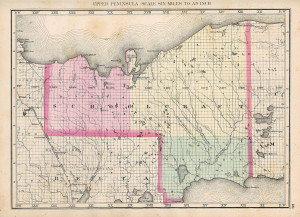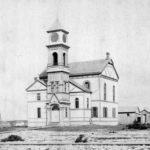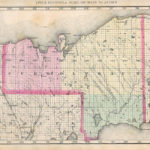
Schoolcraft County Late 1800’s
Schoolcraft county was organized in 1876. It is bounded on the north by Lake Superior, on the east by Chippewa and Mackinac, on the south by Delta and Lake Michigan, on the west by Delta and Marquette. It is the fourth county in the State in size, and has an area of 2,196 square miles. Manistique, a growing town of 700 inhabitants, situated in the southern portion of the county on Lake Michigan, is the county seat. The northern and northwestern portions of the county are heavily timbered with white pine of good quality, growing on land also heavily timbered with maple, birch, and bass wood. The soil in this section is a sandy loam. The middle and western part comprises what is known as the Manistique flats—lands generally level, but with a descent to the southeast sufficient for drainage. Those lands have been largely overflowed, occasioned by beaver dams in the numerous streams or branches of the Manistique. The soil is a vegetable deposit or muck with a subsoil of marl, clay, and sand, underlaid with lime rock. Large marshes are interspersed with grass of the finest quality. The timber is principally pine on the ridges, and spruce, cedar, etc., near the rivers. The eastern and southern portions are more rolling and timbered with hardwood maple, birch, basswood, and elm on the highlands, and cedar, pine, and hemlock on the lower lands. The soil is a dark sand loam on lime rock and clay, and is a very desirable agricultural region. Homestead entries are numerous and the settlers prosperous. This portion embraces a portion of the Manistique lake region. Read More...



